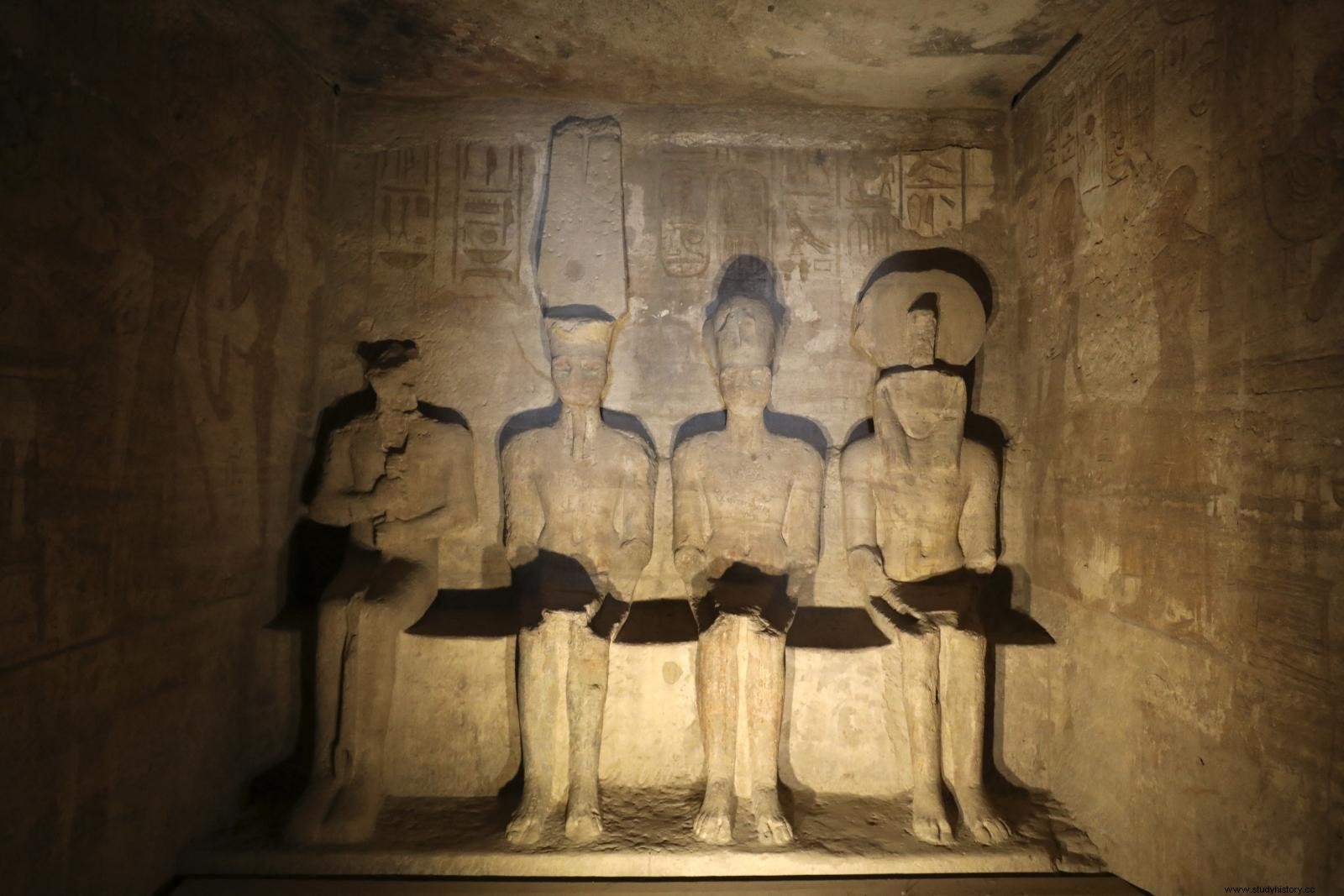The statue of the famous pharaoh Ramses II will be illuminated this Tuesday, February 22, 2022, a phenomenon that only occurs twice a year.

Like every February 22, during an exceptional alignment, the rays of the sun envelop the statue of the sovereign Ramses II, in the temple of Abu Simbel, in southern Egypt.
This Tuesday 22.02.2022 - a palindromic date that can be read from right to left as well as from left to right - the solar alignment of the temple of Pharaoh Ramses II (13th century BC) at Abu Simbel, will officially be celebrated in Egypt, in the presence of Dr. Khaled El-Enany, the Minister of Tourism and Antiquities, as reported by Egyptian media.

The facade of the Abu Simbel temple (Egypt) and its stone giants. Credits:S.Aubin/Leemage/AFP
Carved into a sandstone cliff located 200 km south of the current city of Aswan, the immense Ramesside sanctuary is one of the most impressive architectural jewels of Pharaonic Egypt. Every February 22 and October 22, it is also the subject of a spectacular event, when the rays of the sun penetrate inside the temple for more than 60 meters until reaching, at its end, the holy of saints, or naos :a room where are presented seated on a bench, side by side, the statues of the god Ptah, of Amon, of the divinity Rê-Horakhty equipped with his solar disk, as well as a deified statue of Ramses II. This sovereign of the 19th dynasty reigned for 66 years (1279-1213 BC), a longevity that the examination of his mummy, in France, in 1976, had confirmed since he would have lived to be 92 years old. .

Photo taken in January 2021, showing the four statues present in the holy of holies of the Abu Simbel temple:Ptah, Amon, Re-Horakhty and his solar disc, as well as a statue goddess of Pharaoh Ramses II. Credits:Khaled Desouky/AFP
The rays of the rising sun appear precisely opposite the entrance to the temple
Each February 22, the rays of the rising sun then appear precisely in front of the entrance to the temple, whose facade is decorated with four 20-meter-high giants depicting Ramses II on his throne. All seem to have protected the entrance for more than 3,000 years. Inside, in the huge hypostyle hall 18 meters long entirely dedicated to the glory of the pharaoh, stand eight gigantic polychrome statues with the head of Osiris, each wearing the pschent adorned with the serpent uraeus , who hold in their hands the scepter and the whip emblems of divine power. For a few minutes, in the beams of the dawn, the powerful rays of the sun then radiate a benevolent light on the statues present in the naos . Every February 22, first that of the god Amon is illuminated, then that of Ramses II, draping them in a hue of gold; then on October 22, in the opposite direction, the effigy of Rê-Horakthy ignites first, then that of Ramses II. In both cases, Ptah is never reached by the rays of the sun, because considered by the ancient Egyptians as a god of darkness, he must remain in the shadows.
VIRTUAL TOUR. It is possible to discover the temple of Ramses II at Abu Simbel online with this digital simulation freely accessible on the web.
An orientation retained by 20th century engineers
The Egyptian builders had built the temple dedicated to Ramses II by orienting it precisely so that the first rays projected by the solar star, the most important deity of the Egyptian pantheon, could penetrate to the bottom of the sanctuary. An orientation that the engineers of the 20th century had to keep:in the 1960s, they moved, on the initiative of Unesco, the temple of Ramses II cut into a thousand blocks of 20 to 30 tons , to rebuild it 64 meters above the original site. Which saved him from finding himself under the waves of the 5,000 km
2
of Lake Nasser, in Nubia, during the construction of the Aswan High Dam, decided by the Egyptian authorities in 1955. 
Dismantling of the temple of Abu Simbel, during the rescue of the monuments of Nubia, during the construction of the Aswan High Dam, in the 1960s. Credits:Frédéric Bureau/photononstop/AFP
A feat achieved between 1964 and 1968, which also made it possible to save many other monuments of ancient Egypt from submersion, undoubtedly to date the largest international rescue campaign ever carried out in the entire history of World Heritage. However, this work was not free from difficulties of all kinds, legal, financial and political.
The temple of Abu Simbel was discovered on March 22, 1813 by the Swiss explorer Johann Ludwig Burckhardt, who brought back sketches, then rediscovered and excavated in 1817 by the Italian Giovanni Battista Belzoni. It was however necessary to wait until 1874 to understand the solar alignment of which it is the scene twice a year.
